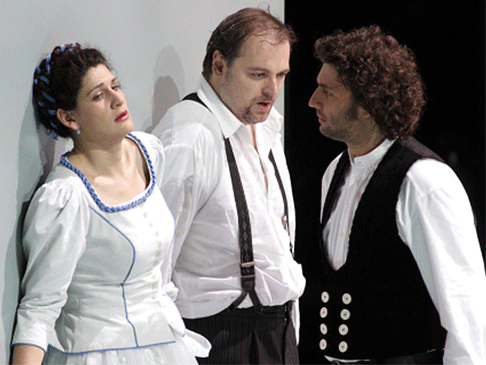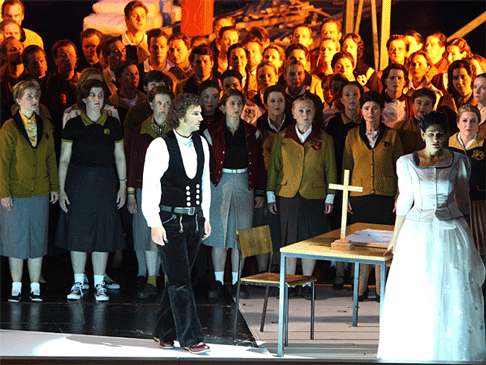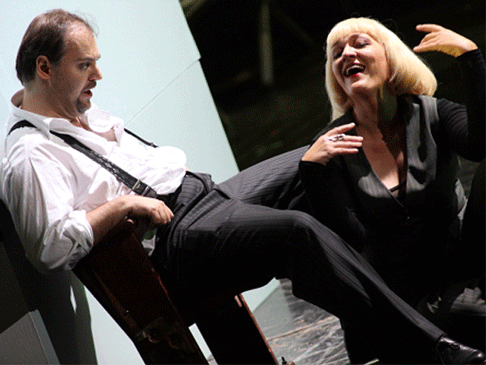Interest was extremely high, of course, in local boy Jonas Kaufmann’s first take on the title role. We were amply rewarded. For Mr. Kaufmann has it all, the mettle and the metal, starting with a robust, baritonal timbre in mid and low-range that loses none of its buzz as he ascends above the staff. His sound technique and focused tone allow him to not only ride the full orchestra as required, but also to scale back to intense, melting piano singing that lovingly caresses the more tender and introspective moments. If In fernem Land had been any more hushed or unearthly beautiful, my heart would likely have stopped. Magnificent.
Add to this, the fact that Jonas is strappingly handsome, eminently stage-wise, and always engaged with his colleagues, and you begin to know that this is a major star in a major step forward in his career (although maybe he should resist doing the part in a house larger than the Staatsoper until he sees how it wears on him). You can also understand why savvy record promoters would perch him atop a mist shrouded summit, Caspar-David-Friedrich-like on the cover photo of his new CD release and declare him “Germany’s most beautiful voice.” The partisan Munich crowd who loudly celebrated his achievement would have agreed.
But they might have argued that German soprano Anja Harteros could also be a worthy target of that encomium. I had greatly admired her Elisabetta in the Oslo Don Carlo but as wonderful as that was, her Elsa could be rightly called ‘definitive.’ Ms. Harteros has a creamy sound production of some gravity that serves her well in all registers. As she flawlessly negotiated every demand of this rangy part, I was reminded of a singer friend who once assessed a performance of Kiri Te Kanawa with mock jealousy, saying “Damn, make a mistake girl!”
But this our soprano did not do, regaling us with a text-book display of impassioned, controlled, varied, yet always lyrical Wagnerian styling. It was interesting too that her voice had been so Italianate in the Verdi, yet here was sometimes deployed with straighter tone, in more conversational delivery. She also looked beautiful, and was a vibrant stage creature that perfectly complemented her leading man. This pairing of Kaufmann and Harteros will likely be celebrated by aficionados for a long time to come.
But although the duo set the bar very high indeed, the rest of the cast was up to challenge. Wolfgang Koch beautifully sang the role of Telramund with an incisive baritone, making music of the many outbursts that most usually shout. Michaela Schuster blazed through Ortrud with relish and imposing vocalism. If her securely hurled upper phrases occasionally tended toward stridency, it perfectly suited this character, and contrasted well with the pristine Elsa. As usual, Christoff Fischesser was reliably solid as the King, and in what is rather a throw-away role, Evgeny Nikitin was a surprising treat with his well-sung Herald.

To say that the orchestra had the finest night I have yet heard from this talented band is a credit to the consummate leadership of conductor Kent Nagano. It is hard to believe that this was my first “live” encounter with the maestro, but it will not be my last. Mr. Nagano led a seamless reading, eliciting spot-on ensemble attaci from all the banks of instruments (especially in those difficult expansive unfolding preludes). The brass were in fine form — nay thrilling form — and the strings just glowed as they poured out arching phrase after arching phrase. The maestro’s attention to detail highlighted several voicings and solos that were absolutely fresh and pleasing to discover.
It was curious that, having snuck onto the podium for Acts One and Two, negating audience “entrance” applause, Mr. Nagano threw that to the winds for a triumphal march into the pit at the start of Three. If he was, as I suspect, approximating the Bayreuth experience (where we don’t see the conductor until the call), why not be consistent? But that is minor, extra-musical carping. The orchestra under Kent Nagano (and chorus, directed by Andrés Máspero) were world-class, festival-class, you-name-it-class … they were of the highest class.
As for the direction by Richard Jones and the physical production, I find there is much good to be said. Mr. Jones took as his central “Konzept” an idea that Elsa aspires to be a proponent of ideals for the “construction” of a new order as the country was perched on the verge of civil war. Mr. Jones realized his metaphor as a literal “construction” of (what turns out to be) Elsa’s and Lohengrin’s Wedding House. (It must be said the stage management and running crew did remarkably fine work all night long.)

Whatever one might think of the process of watching this house (aka new social order) get actually built over the course of the opera, or of having Elsa in work clothes laying bricks, this was a hugely impressive set design from Ultz, who also contributed the effective costumes. By the end of Act Two, a complete two-story chalet with balcony has been constructed and a turntable spins it around for us to admire.
And then … even as it spun … the vociferous catcalls began. (Oh, dear, and a whole act to go!) I can appreciate that the visual embodiment of the “construction” may have been heavy handed, and that some may have wished for a design more akin to a period Belgian tapestry (and perhaps Lauritz Melchior back to sing in it), but really, I found that this was a handsome, very polished design that was considerate and consistent.
Moreover, it was beautifully lit by Mimi Jordan Sherin, who took advantage of its natural color to unleash a full palette of evocative lighting effects on it, abetted by videographer Silke Holzach. Only the projection of the rising horizontal green and black lines (like an old TV test pattern) was of perplexing intent.
Director Jones was a master of clarity and focus. All the while the stage was peopled with extras building the house, we were never distracted, and the characters always interacted meaningfully. Among the beautiful touches was having Lohengrin arrive bearing the swan as if being led by it. And having him carry a baby crib to the wedding house’s upstairs room, only later to put it on the bed and torch it, after Elsa’s betrayal (shades of Waco!).

In fact, cultism seemed to be more the new order than any ideal of Elsa’s. At the start, the citizens were dressed in stylized blazers and faux folk dress, with the men’s hair swept up and out like an old hood ornament on a Chrysler. Very Flemish kitsch-inspired. Then Lohengrin arrived in a modern pale blue tee shirt and jogging pants with a silver stripe. In a visual irony, the citizenry became converts to Lohengrin/Elsa and donned blue tees, while the love couple got wed in rather traditional folk dress. As Ortrud offed herself and the chorus followed suit, there were echoes of Jonestown, underscoring the occasional peril of following charismatic leaders. This was richly complicated imagery and it not only complemented Wagner, but really it represented his intent.
Did everything work? No. The goofy duel between Lohengrin and Telramund looked like un-coordinated pre-pubescent boys flailing Star Wars light sabers. And the moment misfired when Telramund rushed in to murder the hero, with Elsa standing on the wedding bed and brandishing a sword, and Telramund falling dead without having come anywhere near the lethal weapon. Spatially, it made no visual sense.
Still, at the end of the day, this Lohengrin was always interesting, if occasionally flawed work from a very talented production team, well served by a cast and orchestra who were utter perfection. And isn’t that ample cause for rejoicing?
James Sohre
![Scene from Lohengrin [Photo by W. Hösl courtesy of Bayerische Staatsoper]](http://www.operatoday.com/Lohengrin_Munich_2009_03.gif)


